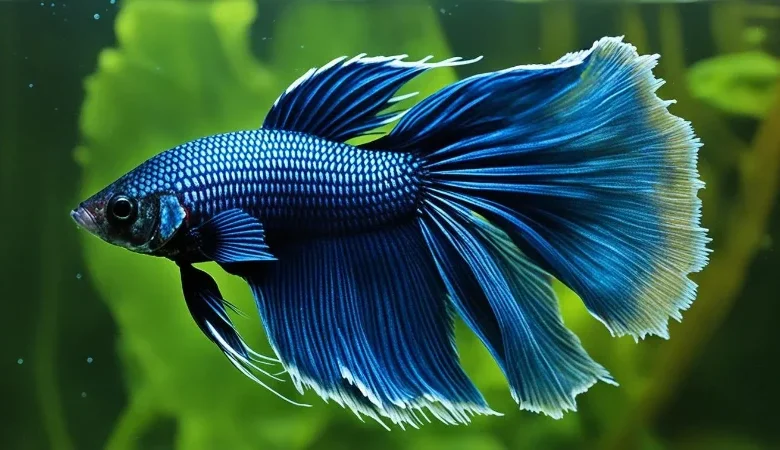
Do you notice your betta fish acting sick? Understanding common betta fish parasites and diseases is key. It helps keep these lively freshwater fish healthy. Diseases like ich are serious. Knowing their signs and treating them on time can save your pet.
Bettas, also called Siamese fighting fish, are often pets at home or work. They usually live 2-4 years, but some may live longer. If your Betta fish seems sick, quick action is crucial. Betta fish enthusiasts recommend having medicine ready for common ailments. This preparation can help your fish fight off illness.
What are the top parasites for betta fish? How can you spot and treat them? Let’s look closer at betta fish parasites. Learning about them can keep your colorful friend in good health.
Understanding Betta Fish Parasites
Betta fish can get diseases like bacterial, fungal, and parasites, similar to other fish. Some common diseases are Columnaris, Dropsy, and Fin & Tail Rot. Others like Ich/Ick, Velvet, Popeye, and Septicemia (Red Streaks) are also seen. It’s important to know them and treat your betta early for its health.
What are Betta Fish Parasites?
Parasites are a big problem for betta fish. These tiny creatures can cause big health issues and even the death of your fish. They might come in with new fish or plants, from bad water, or other ways. Knowing what to look for and treating early is key.
Common Types of Parasites Affecting Bettas
Betta fish often get parasites like Anchor Worms, Gill Flukes, Fish Lice, and Internal Parasites. Each one shows different signs and needs its treatment. Understanding these can help your betta recover better.
It is important to note that diagnosing betta fish parasites can be challenging, as many symptoms can overlap with other diseases. Seeking expert advice can help in accurate diagnosis and appropriate treatment.
Dr. Rebecca Johnson, Fish Expert
Signs of Parasitic Infections in Bettas
Sick betta fish often show unique signs which could point to a parasitic infection. Look out for problems like torn or strange-looking fins, a color change, and eyes that stick out too much. They might also have white spots or new bumps on their skin. Watching how your betta looks can quickly alert you to any health troubles.
Behavioral Changes in Infected Bettas
A betta fish with a parasitic disease might act differently too. It could seem lazy, not want to eat, or pick weird spots to hang out in the tank. It might also scratch itself a lot on things in the tank. Spotting these odd behaviors early can be key to treating your sick fish in time.
Anchor Worms
The anchor worm is a big threat to betta fish. It’s a tiny crustacean that digs into the fish’s body. If not treated, it can cause big problems. This parasite, Lernaea spp., affects many types of freshwater fish, including bettas.
Identifying Anchor Worms
Spotting an anchor worm is quite easy. Look out for a white, green, or reddish worm-like thing sticking out from under the betta’s fins. These parasites attach to the fish and go inside the body, making the fish uncomfortable and at risk for more infections.
Treatment Options for Anchor Worms
Getting rid of anchor worms by hand is not a good idea. It’s too stressful for the fish. Instead, use special chemicals like potassium permanganate, Cyropro, Dimilin, and take salt baths. However, these chemicals only work on young parasites. For older anchor worms, a vet’s help might be needed.
Preventing Anchor Worm Infestations
To avoid anchor worm issues, quarantine new plants or fish for a month. This stops parasites from getting to your betta. Make sure the water in the tank is clean and the space is not too crowded. This helps keep your fish safe from anchor worms.
Columnaris (Cotton Wool Disease)
Columnaris is a fast-spreading bacterial illness that often kills betta fish. It’s usually due to poor filtration, too many fish in one tank, or low oxygen levels. Signs include white or gray spots on the fish’s body or gills, as well as on their fins.
Recognizing Columnaris in Bettas
Known as cotton wool disease, it shows as white or grayish patches on the betta fish. These patches may become open sores. The fish can seem tired, not eat, and have trouble swimming.
Treating Columnaris Infections
Treating this disease means using two antibiotics: kanamycin and nitrofurazone. It’s also very important to keep the tank clean to stop it spreading. Lessening the number of fish and lowering the water’s temperature can also aid in treatment.

Ich (White Spot Disease)
Ich, or White Spot Disease, is very common in betta fish. It comes from a parasite and causes small white dots on their bodies and fins. Fish with ich might try to scratch themselves on tank objects to get rid of these parasites.
Symptoms of Ich in Bettas
One of the key signs of ich is the look of tiny white spots, like salt or sugar, on a betta’s body. They may seem tired, not eat, and rub against things in the tank. This is because they’re trying to ease the itchiness from the parasites.
Effective Treatments for Ich
Dealing with ich usually means using a few methods. One good way is to make the water warmer, about 85°F, to kill the parasites. You can also use medicines with formalin or malachite green. Adding aquarium salt helps too, just one teaspoon for every 2.5 gallons of water.
Preventing Ich Outbreaks
To stop ich, it’s key to quarantine new plants or fish first. Keep the water clean, lower stress, and watch your fish’s health to boost their immune system. If ich does show up, treat all the fish in the tank, not just the ones that look sick, to make sure the parasites are stopped.
Velvet Disease
Velvet disease is a serious threat to betta fish. It’s caused by a tiny parasite called Oödinium. This parasite makes a gold dusting appear on the fish’s body, gills, and fins. Affected bettas might act stressed, like darting around and rubbing against things.
Identifying Velvet Disease in Bettas
It’s hard to tell when a betta has velvet disease. The fish might look like it has a velvet-like coat. It can also have trouble breathing and act differently. Sometimes, their color changes to orange or they get orange or yellow spots.
Treatment Options for Velvet Disease
But, velvet disease can be treated. React quickly! Raise the water’s temperature to 76-81°F. Use special medicine, like Mardel Copper Safe. Keep the water clean and free of stress to help your betta heal.

Gill Flukes
Gill flukes are a kind of flatworm called Dactylogyrus. They can infect many types of freshwater fish, including bettas. If not treated, these parasites can harm your betta fish.
Signs of Gill Fluke Infestations
Betta fish with gill flukes show some signs. They may breathe heavily, have dull eyes, and rub on things in their tank. These actions are because the parasites affect their gills. This makes it hard for them to breathe.
Treating Gill Flukes in Bettas
Vets should treat bettas with gill flukes. They might use special medicines or other treatments. These could include baths in salt, and using formalin. Maintaining clean water and quarantining new fish can help prevent gill flukes.
Gill flukes are not common in bettas, but they can harm the fish if not treated. Bettas can recover if you act fast. This helps the fish stay healthy in their tank.
Internal Parasites
Internal parasites are one of the toughest issues for betta fish. They’re tiny worms that come from bad food or water. These worms don’t make bettas look sick outside, yet they cause many problems on the inside.
Recognizing Internal Parasitic Infections
If your betta has internal parasites, you might notice some strange actions. These could be being very tired, not wanting to eat, or getting skinnier. They might also stay at the top or bottom of the aquarium and have trouble swimming.
Seeing these signs can be hard because they can mean other things, too. Watching your fish closely is the best way to catch this problem early.
Treatment Approach for Internal Parasites
To treat internal parasites, bettas should fast for a few days to clear their stomach. Then, they can take medicine like Fritz ParaCleanse or PraziPro. You can also feed them special foods like daphnia or a little pea to fight the worms.
Prevention is always better, so keep the tank clean and your betta eating well. Fish from the wild often carry internal parasites, so any new fish must be quarantined before adding them to your aquarium.
Conclusion
Betta fish can get sick from various parasites, bacteria, and fungi. With the right care, many of these illnesses can be treated. Knowing about these diseases, their symptoms, and how to treat them helps betta owners keep their fish healthy.
To avoid parasites, checking the water and ensuring new fish are kept separate is vital. Learning about these steps and sticking to them helps protect bettas from getting sick. This way, they can live happily and brightly without the risk of disease.
Watching your fish closely and acting fast if they seem unwell is key. By following the advice in this guide, your bettas are more likely to stay well. This means they can keep on making their owners happy for a long time.



